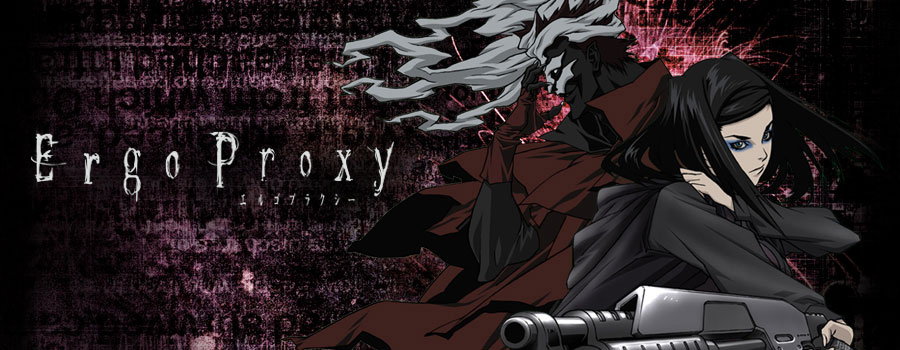Ergo Proxy (TV)
Go back to Ergo Proxy main page
The name of the show comes from two words "ergo", which means therefore or consequently, and "proxy", which means a person authorized to act for another; an agent or substitute. Literally, Ergo Proxy might mean "therefore an agent or a substitute", which sounds like a concluding phrase. It remains to be seen however, as the official website describes the title in Japanese as "death agent or substitute".
Ergo Proxy bears a lot of resemblance to another famous cyberpunk anime, the Ghost in the Shell series. Both anime feature androids living amongst humans, question the meaning of existance and finding out the scopes and limits of the mind.
A spin-off manga of Ergo Proxy, named Centzon Hitchers and Undertaker, is currently serialized by Shogakukan Monthly Magazine Sunday GX starting from March 2006.
The Turing function referred to in the first episode is a reference to the Turing test, a test for machine consciousness suggested by computer scientist Alan Turing. The premise behind the test is that natural conversation is such an intuitive process that any machine that can replicate it must have achieved it. The test, thus, involves a human being having a conversation with two unknown partners, one human and one machine. If the human being is unable to distinguish which is the machine and which is human, the machine is seen as having passed the test.
Inside Regent Donov Mayar's chamber, the stature of two reclining figures on the right is based on Michelangelo's Night and Day stature placed above Giuliano di Piero de' Medici's sarcophagus in Medici Chapel, Florence. In the show, the female figure (Night) represents the voice of Lacan and the male figure (Day) the voice of Husserl. The stature on the left is based on Michelangelo's Twilight and Dawn stature placed above the sarcophagus of Giuliano di Lorenzo de' Medici in Medici Chapel. In the show, the female figure (Dawn) represents the voice of Derrida and the male figure (Twilight) the voice of Berkeley.
Episode 3's title (無への跳躍) is taken from the title of a science fiction novel Прыжок в ничто (Leap into the Void) by Alexander Beliaev.
Episode 1 begins with a quotation from Michelangelo's reply to Giovan Battista Strozzi's epigram [2] for the Night (Night Stature in Medici Chapel). The opening sequence from Episode 3 onwards features fragments of this quotation in Italian as background graphics montage.
In the prologue to episode 10, there is a graveyard scene. A tombstone is shown for a moment, bearing the words "CHIEF WRITER Dai Sato". Dai Sato is the real chief scriptwriter for the show.
The artwork on the DVD Volume 1 Box bears a striking resemblance to the front cover of the band Evanescence's CD "Fallen."
The character of Pino was given this name as a reference to both Pinocchio, and Pinoko a character from the anime Black Jack. Pino just like Pinocchio wishes to be a "real child".
The cellular structure of the proxy consists of "Amrita cells" which are immortal and auto- regenerative. the origin of this name can be linked to the sanskrit work Amrit that means the elixir of life.
In episode 1, it spells "awakenings" in Vincent's cereal, just like it spells "misfit" in the dream sequence in ep. 4
In episode 3, we get a brief glimpse at Real's ID card. Her number imprinted on it is re-124C41+, which also appears as a title on episode 7. re-124C41+, when read verbally, strangely means "Real one to foresee for one."
In episode 4, in Vincent's dream, the word "misfit" was spelled by the alphabet cereal he was preparing.
In Episode 4, the character Hude is reading poetry by Joë Bousquet, a 20th French surrealist poet who later had enormous influence on Gilles Deleuze.
| You can contribute information to this page, but first you must login or register |
| DISCLAIMER | add information | report an error | lookup sources |

